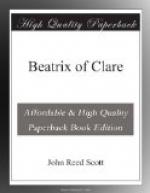The Prior sprang to the front of the dais.
“Long live the King!” he shouted.
And the monks, wild with joy at release from their hard master, jumped on the benches crying:
“Long live the Royal Richard! Long live the King!”
XXIV
“WHEN YOU HAVE TOPPED THESE STAIRS”
For an hour Raynor Royk and his men searched every nook and corner of the Abbey, sounding walls and floors and making a confusion such as the stately establishment had never known. But they found neither the Countess nor the Abbot. He had either escaped by one of the passages through which he introduced his frail companions, or he was hiding in some secret chamber—whence he would take good care not to issue until the Knights had departed.
And to provide for just such contingency De Lacy, on the morrow when the march was resumed, detailed five of the royal men-at-arms to remain at Kirkstall. The armed retainers of the Abbey, who had been made prisoners the instant De Bury and he entered the place, he now relieved from service there and enrolled them among his own following. They were sturdy soldiers enough, albeit they had little to do but to wax fat and sluggish by inaction and much food and, occasionally, to escort the Abbot when he went abroad. Yet they were glad to be admitted to the service of one who wore the Boar and they donned corselet and casquetel with eagerness and haste—as willing now to fight against the Cistercian as, an hour since, they were ready to defend him.
The Castle of Roxford lay some four leagues northwest of the Abbey. It had been the seat of the Lords of Darby for two centuries and more; and while in no way comparable with the huge Pontefract, in either size or strength, yet it was deemed a formidable fortress and one, when properly garrisoned and defended, well able to withstand attack.
A broad path led from the highway half a league or so through the forest of oaks and beeches to the castle, which stood on a slight eminence in the centre of a wide clearing covered with luxuriant turf, and used for pasturing the domestic animals as well as for the sports of the garrison. But the morning after the events at Kirkstall, when Sir Aymer de Lacy and Sir John de Bury halted near the edge of the timber, this open space was bare of denizen, either brute or human. Nor did the fortress itself show more animation; for though they rode slowly around its entire circle, keeping the while well under cover of the trees, yet not a sign of life did they discover either without or within. Save for the small sable banner with the three golden escallops, which fluttered in gentle waves from the gate-tower, there was no moving thing in all the landscape.
“It is uncommonly queer, this quiet,” said De Bury, shading his eyes with his hand to see the better. “It would almost seem they had been warned of our coming.”




